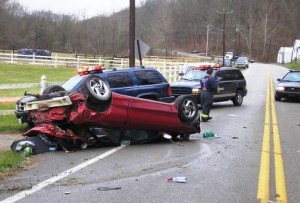
Government data reveals that while highway fatalities are declining, distracted driving deaths have been rising.
New federal guidelines could soon put strict limits in place on the use of high-tech infotainment systems – but are the proposed rules missing some of the most blatant contributors to distracted driving?
That’s a point that several automakers plan to raise during hearings today that are expected to help define new rules aimed at limiting distracted driving. The rules under study by the National Highway Traffic Safety Administration would impact technology such as the Ford Sync system and Toyota’s EnForm, but manufacturers argue that the new guidelines should also include portable devices brought into a vehicle.
“Our idea is that people should not be distracted by anything,” said Transportation Secretary Ray LaHood.
U.S. highway fatalities fell to their lowest level ever last year when adjusted to reflect the ever increasing number of miles driven by American motorists. But the good news was tempered by the fact that federal data showed one of every 11 highway fatalities came as the result of texting, cellphoning or some other form of distracted driving.
The National Transportation Safety Board, or NTSB, last year proposed extensive rules that would have barred the use of most infotainment technology while a vehicle is moving. LaHood rejected that proposal, which many observers described as too draconian, but NHTSA, which oversees federal automotive safety mandates, is now in the process of development its own guidelines.
Among other things, the agency is expected to restrict the ability to use a built-in infotainment system for texting, e-mailing or surfing the Web. But automakers complain that the rules wouldn’t necessarily cover the use of a handheld smartphone, for example. And while most makers already “lock out” the keypad for entering a destination while the vehicle is in motion there are no such limits on most portable navigation systems.
“Is that tiny screened portable device with no industry driving safety guidelines irrelevant?” Tom Baloga, vice president of engineering for BMW North America, asked during an interview with USA Today.
The NHTSA proposal – which is now facing mandatory hearings across the country – largely mirrors guidelines already put into place by the trade group the Alliance for Automobile Manufacturers. Officials with the AAM are expected to ask that makers of portable electronic devices also be included.
While that industry’s trade group, the CTIA, has urged its members to consider safety issues they have so far failed to come up with a complete set of standards. Some wireless industry officials ask how that would be possible. And should a system that might detect when a vehicle is in motion, for example, be able to lock out everyone in a car, even those in the back seat? Would it be possible to determine when a smartphone is being used by the driver?
If the NHTSA guidelines go into effect as now proposed, they would require automakers to determine that a task, such as tuning the radio or operating any other electronic system, be able to be completed with a minimal amount of distraction. That would mean no more than six glances taking a driver’s eyes off the road for a maximum two seconds at a time.
And texting, e-mailing, web surfing and navigation input would be blocked entirely.
